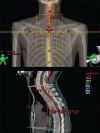Radiation-induced spinal cord glioblastoma with cerebrospinal fluid dissemination subsequent to treatment of lymphoblastic lymphoma
- PMID: 23532877
- PMCID: PMC3604819
- DOI: 10.4103/2152-7806.107905
Radiation-induced spinal cord glioblastoma with cerebrospinal fluid dissemination subsequent to treatment of lymphoblastic lymphoma
Abstract
Background: Radiation-induced glioma arising in the spinal cord is extremely rare. We report a case of radiation-induced spinal cord glioblastoma with cerebrospinal fluid (CSF) dissemination 10 years after radiotherapy for T-cell lymphoblastic lymphoma.
Case description: A 32-year-old male with a history of T-cell lymphoblastic lymphoma presented with progressive gait disturbance and sensory disturbance below the T4 dermatome 10 years after mediastinal irradiation. Gadolinium-enhanced magnetic resonance (MR) imaging revealed an intramedullary tumor extending from the C6 to the T6 level, corresponding to the previous radiation site, and periventricular enhanced lesions. In this case, the spinal lesion was not directly diagnosed because the patient refused any kind of spinal surgery to avoid worsening of neurological deficits. However, based on a biopsy of an intracranial disseminated lesion and repeated immmunocytochemical examination of CSF cytology, we diagnosed the spinal tumor as a radiation-induced glioblastoma. The patient was treated with radiotherapy plus concomitant and adjuvant temozolomide. Then, the spinal tumor was markedly reduced in size, and the dissemination disappeared.
Conclusion: We describe our detailed diagnostic process and emphasize the diagnostic importance of immunocytochemical analysis of CSF cytology.
Keywords: Glioblastoma multiforme; nonHodgkin's lymphoma; radiotherapy; spinal cord.
Figures




Similar articles
-
[A case of spinal glioblastoma with intracranial dissemination].No Shinkei Geka. 1993 Dec;21(12):1109-12. No Shinkei Geka. 1993. PMID: 8259221 Japanese.
-
Spinal metastasis of glioblastoma multiforme: an uncommon suspect?Spine (Phila Pa 1976). 2010 Apr 1;35(7):E264-9. doi: 10.1097/BRS.0b013e3181c11748. Spine (Phila Pa 1976). 2010. PMID: 20195200
-
[A case of primary intramedullary spinal cord lymphoma diagnosed by spinal cord biopsy of long spinal cord lesions showing persistent gadolinium contrast enhancement].Rinsho Shinkeigaku. 2021 Dec 22;61(12):856-861. doi: 10.5692/clinicalneurol.cn-001655. Epub 2021 Nov 18. Rinsho Shinkeigaku. 2021. PMID: 34789630 Japanese.
-
Exophytic Primary Intramedullary Spinal Cord Glioblastoma: Case Report and Critical Review of Literature.World Neurosurg. 2019 Feb;122:573-576. doi: 10.1016/j.wneu.2018.11.113. Epub 2018 Nov 23. World Neurosurg. 2019. PMID: 30476666 Review.
-
Remarkable efficacy of temozolomide for relapsed spinal myxopapillary ependymoma with multiple recurrence and cerebrospinal dissemination: a case report and literature review.Eur Spine J. 2018 Jul;27(Suppl 3):421-425. doi: 10.1007/s00586-017-5413-z. Epub 2017 Dec 21. Eur Spine J. 2018. PMID: 29270703 Review.
Cited by
-
Radiation-induced glioblastoma of the conus medullaris from radiation treatment of cervical cancer.BMJ Case Rep. 2020 Dec 17;13(12):e238372. doi: 10.1136/bcr-2020-238372. BMJ Case Rep. 2020. PMID: 33334766 Free PMC article.
-
Recurrence of cervical intramedullary gliofibroma.Spinal Cord Ser Cases. 2021 Nov 5;7(1):97. doi: 10.1038/s41394-021-00461-y. Spinal Cord Ser Cases. 2021. PMID: 34741004 Free PMC article.
-
Intramedullary Glioblastoma as One of Multiple Radiation-Induced Neoplasms.Case Rep Oncol. 2025 Apr 17;18(1):682-693. doi: 10.1159/000545250. eCollection 2025 Jan-Dec. Case Rep Oncol. 2025. PMID: 40487555 Free PMC article.
-
Radiation-induced gliomas: a comprehensive review and meta-analysis.Neurosurg Rev. 2018 Jul;41(3):719-731. doi: 10.1007/s10143-016-0786-8. Epub 2016 Oct 5. Neurosurg Rev. 2018. PMID: 27709409 Review.
References
-
- Abel TJ, Chowdhary A, Thapa M, Rutledge JC, Geyer JR, Ojemann J, et al. Spinal cord pilocytic astrocytoma with leptomeningeal dissemination to the brain. Case report and review of the literature. J Neurosurg. 2006;105:508–14. - PubMed
-
- Andrews AA, Enriques L, Renaudin J, Tomiyasu U. Spinal intramedullary glioblastoma with intracranial seeding. Report of a case. Arch Neurol. 1978;35:244–5. - PubMed
-
- Bazan C, 3rd, New PZ, Kagan-Hallet KS. MRI of radiation induced spinal cord glioma. Neuroradiology. 1990;32:331–3. - PubMed
-
- Bell WO, Packer RJ, Seigel KR, Rorke LB, Sutton LN, Bruce DA, et al. Leptomeningeal spread of intramedullary spinal cord tumors. Report of three cases. J Neurosurg. 1988;69:295–300. - PubMed
-
- Claus D, Sieber E, Engelhardt A, Rechlin T, Neubauer U, Volk B. Ascending central nervous spreading of a spinal astrocytoma. J Neurooncol. 1995;25:245–50. - PubMed
Publication types
LinkOut - more resources
Full Text Sources
Other Literature Sources

